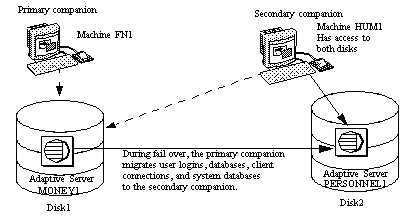An asymmetric configuration consists of two Adaptive Servers running on separate machines. The primary Adaptive Server performs the work during day-to-day operations, while the secondary Adaptive Server is prepared to take over the work during a system failure or scheduled maintenance. The secondary companion is an independent Adaptive Server, and can have its own applications running. To configure for fail over, the secondary companion must be a newly installed Adaptive Server, and cannot yet have any user logins or user databases. After configuration is complete, you can add user logins and databases to the secondary companion.
When you install and configure Adaptive Server for fail over, Adaptive Server is in single-server mode. Use sp_companion to change it from single-server mode to a companion server in an asymmetric setup. See the Reference Manual: Procedures for information about sp_companion.
Figure 3-1: Asymmetric configuration in high availability system

In this setup, MONEY1 is the primary companion and fails over to PERSONNEL1, the secondary companion. Both disks are visible to machine HUM1, which connects to machine FN1 with a dual-ported SCSI. Because this is an asymmetric setup, PERSONNEL1 cannot fail over to MONEY1. Disk1 must be shared, and Disk2 can be a local disk.
See the appropriate platform-specific configuration chapter for detailed information about configuring Adaptive Server for an asymmetric setup.